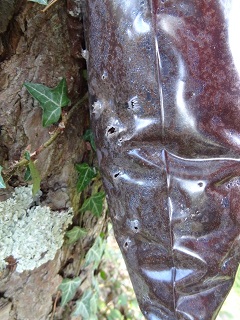The size of the Écopiège® collar and accessories depends on the circumference of your tree and the number of nests present. To support you, we provide you with a table in which you only need to indicate the circumference of your tree (in cm), the number of nests and you will get the summary of what you need. Click here to access the table.
1 - What size should I choose for the Écopiège® collar and what are the accessories?
2 - Is the Écopiège® collar easy to put on?
The Écopiège® collar has been specially designed for easy and fast fitting. It takes only about 20 minutes to put it on. No particular tool is necessary (apart from a cutter). For trees with a larger circumference, it is advisable to use two to assemble it and to facilitate installation..
3 - Does the Écopiège® collar bag need to be changed every year?
It is essential to change the bag of the Écopiège® collar every year. It is necessary to wait for the end of the processions and the beginning of the transformation of the caterpillars into pupae to remove the bag safely. This corresponds to the end of May.
4 - What to do with the Écopiège® collar bag?
You must burn the Écopiège® collar bag yourself or wrap it in a thick, sturdy garbage bag and dispose of it with your household waste.
5 - At what height should the Écopiège® collar be placed?
As a preventive measure, it is strongly recommended to place the Écopiège® collar out of reach of children and animals. That it’s to say about two meters high, to prevent the risk of urticaria.
6 - I have processionary caterpillars in my garden, is it too late to place an Écopiège® collar?
 If you find some processionary caterpillars in your garden, it is not necessarily a sign that they are in their processionary phase. They may have fallen out of the nest because of wind or a weakness for example. When caterpillars are in procession, they come down the tree trunk in single file and by the hundreds. If you see a procession, it is a sign that a nest is emptying. There is one procession per nest. If your tree is infested by several nests, it is still time to get an Écopiège® collar to prevent the next processions from coming down in your garden.
If you find some processionary caterpillars in your garden, it is not necessarily a sign that they are in their processionary phase. They may have fallen out of the nest because of wind or a weakness for example. When caterpillars are in procession, they come down the tree trunk in single file and by the hundreds. If you see a procession, it is a sign that a nest is emptying. There is one procession per nest. If your tree is infested by several nests, it is still time to get an Écopiège® collar to prevent the next processions from coming down in your garden.
7 - I have processionary caterpillars in my garden, what can I do?
If there are caterpillars that have walked in procession in your garden, it is advisable to irrigate with plenty of water the path where they have passed and the place where they are buried to drain all the hairs present. Indeed, even if it is an indirect contact with the stinging hairs, it can be dangerous. Let the caterpillars bury themselves and dig them up a month later, taking care to protect yourself. Then put them in a thick, sturdy garbage bag and dispose of them with household waste.
8 - After a downpour, the water does not drain out of my Écopiège® bag. What can I do?
The bag is specially designed to evacuate rain. However, it may happen in the event of a downpour that the bag fills with water. In this case, it is advisable to perforate the bottom of the bag with a small diameter nail. It is important not to pierce the bag because there remains an important risk of dispersion of the hairs through larger holes. The caterpillars will not come out of these holes because once they are in the soil of the bag, they will not seek to go down anymore.
9 - Coal titmice pierce the bag of my Écopiège® to catch the caterpillars inside. Can it be serious?

The caterpillars will not come out of these holes because once in the soil of the bag, they do not seek to go down any further. No intervention is then necessary.